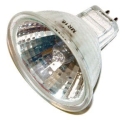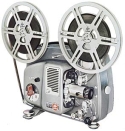Digital projection has largely taken over from traditional film projection in just about every area. In movie theaters, digital projection is more and more replacing the old spools of film to the point that they may soon become a distant memory. At home, video projectors are becoming less expensive and are able to play high-resolution BluRay discs. Is there any room left, then, for those of us who like to watch old-fashioned films, or is digital projection simply better in every possible way.
In this article, I will discuss the various pros and cons of both digital projection and film, and try to find a niche for film if not in some theoretical sense but in our hearts.
Benefits of Digital Projection
Digital Projection has a number of advantages over film, mostly relating to convenience. Basically, digital projection takes up less space and is easier to use than film projection.
Compactness
First, digital projection has the advantage that it is more compact than film projection. The entire movie fits on a little disc the size of a CD. The projector itself is also more compact, as there is no need for extra room for spools and reels.
For watching full-length feature films, 8mm film and 16mm film requires multiple reels of film. This means that one must find a place to store all of that extra footage.
Convenience
Digital projection is much more convenient to use. With film projection technology, one must thread the film, use a spool to catch the film and then rewind the film at the end. For a digital projector, one simply pops in the disc and hits play.
In addition, digital projection allows one to hop around within a movie, choosing favorite scenes. Film projectors don’t have any sort of “fast forward”, “rewind” or “skip” option, because that would require physically moving the disc.
Benefits of Film Projection
Film projection, however, still has a few advantages over digital projection. The image is better (or, rather, better in different ways), and the manual inconveniences of film projection provide a less alienating effect.
Picture Quality
Every once in a while, you’ll hear that digital picture is “indistinguishable” from film projection. In some cases, this is almost true – if you don’t know what to look for. However, what it shows is important. Film projection will always be the standard according to which digital projection is judged.
The reason is fairly simple. Digital projection necessarily has a resolution. At the end of the day, it’s a bunch of little squares. The higher the resolution gets, the better it can trick your eyes that it’s not really a bunch of squares, but is instead some sort of curve or landscape. The problem is that, for curves or during rapid motion, the pixellation will start to show. This is especially true for home projectors where the digital projection is often blown up to larger sizes than the office presentation equipment that is usually sold as film projecting equipment.
On the other hand, film doesn’t use any pixellation. That isn’t to say that film doesn’t have higher and lower levels of quality, far from it. 32mm film is better than 16mm film which is better than 8mm film. However, the when an image becomes too detailed for the film sized, the edges become slightly blurry, not pixellated.
This blurriness is important because this is what happens when we can’t focus on a detail with our eyes. In other words, film images are imprecise in the same way that vision is imprecise. When a film detail can’t be seen it looks just like other things that we can’t see. Pixellation, on the other hand, looks unnatural. Moreover, the more one understands how pixellation works, the worse it looks.
Hands On
Another advantage of film viewing is precisely that it is more hands on than digital projection. Certainly, convenience is nice in some cases, but it is not the only thing that matters. It is often for more pleasant to do something for oneself, rather than to have it all done for you.
It’s for this reason that film projection has become something of a niche interest. Activities that require extra steps become hobbies for those that engage in them. Sure, it might be true that you can just buy some completed, but it often creates a sense of accomplishment to put it together oneself.
In a way, film projection is like reading books. It’s true that Kindle etc. are more convenient, but people like the sense that they are interacting with their environment, not that they are simply looking at artificial screens. Since film projection already involves an artificial image, film projection has a way of bringing this experience more down to Earth.
Conclusion
Film projection has been steadily losing out to digital, but film will still have a place for a long time. It is the standard by which digital is judged, and digital projection is still far from perfect, especially at home. Moreover, it is a way of enjoying the experience of watching a movie in a direct and hands-on way.



